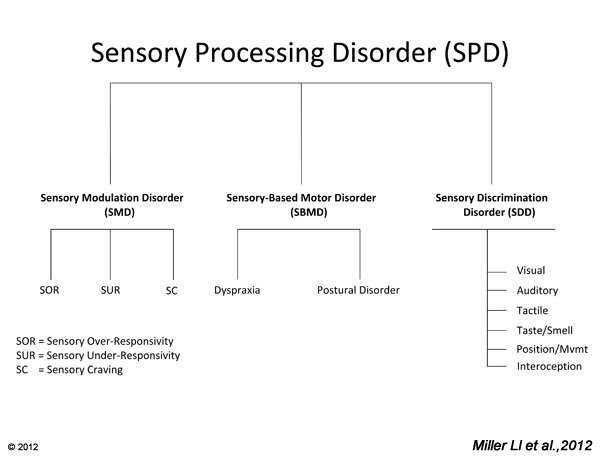What is Sensory Processing Disorder?
Sensory processing refers to the way the nervous system receives messages from the senses and turns them into responses. For those with Sensory Processing Disorder, sensory information goes into the brain but does not get organized into appropriate responses. Those with SPD perceive and/or respond to sensory information differently than most other people. Unlike people who have impaired sight or hearing, those with Sensory Processing Disorder do detect the sensory information; however, the sensory information gets “mixed up” in their brain and therefore the responses are inappropriate in the context in which they find themselves.
Sensory Processing Disorder (SPD)
〰️
Sensory Processing Disorder (SPD) 〰️
Sensory Processing Disorder or SPD (originally called Sensory Integration Dysfunction) is a neurological disorder in which the sensory information that the individual perceives results in abnormal responses. A more formal definition is: SPD is a neurophysiologic condition in which sensory input either from the environment or from one’s body is poorly detected, modulated, or interpreted and/or to which atypical responses are observed. Pioneering occupational therapist, psychologist, and neuroscientist A. Jean Ayres, Ph.D., likened SPD to a neurological “traffic jam” that prevents certain parts of the brain from receiving the information needed to interpret sensory information correctly.
People with SPD misinterpret everyday sensory information, such as touch, sound, and movement. They may over-respond and find clothing, physical contact, light, sound, food, or other sensory input unbearable. Or they may under-respond and show little or no reaction, not even to pain or extreme hot and cold. A third option is sensory-motor problems, including weakness, clumsiness, awkwardness or delays in acquiring gross and/or fine motor skills. Children with SPD often demonstrate issues with emotional regulation, behavior, social interaction, attention, and/or motor coordination.
Our current knowledge suggests that there are six subtypes of SPD. Almost all individuals with SPD have a combination of symptoms from more than one subtype. The chart below shows the three major patterns and the six subtypes of SPD.
Occupational therapy focuses on priorities identified in collaboration with your family. Goals typically include increased social participation, self-regulation and self-esteem. Sensory-based therapy addresses developmental issues related to SPD: modulation of sensation, motor planning, motor control and postural control. OT sessions are structured to provide your child with challenges that promote growth while at the same time providing success experiences. Tools that are used in sensory integration therapy include interventions such as Integrated Listening Systems, The Listening Program with bone conduction, Interactive Metronome, the Astronaut Program, Brain Gym, Reflex Integration and Zones of Regulation.
Parent coaching is an integral piece of our approach. Parents must understand how their child takes in the sensations of the world around them and how this impacts their ability to function in the world. By developing a solid understanding of your child's individual processing differences we can work as a team to implement strategies, which support your child's development.
Information on this page taken from Star Center, Colorado. Thanks to Lucy Miller.



